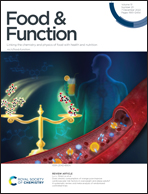The stability and spicy taste masking effect of capsaicin loaded α-lactalbumin micelles formulated in defatted cheese†
Abstract
Capsaicin (Cap) is a promising bioactive compound having many health-promoting benefits. However, it is difficult to be applied in food due to its poor aqueous solubility, low stability and bioavailability. Besides, its strong spicy taste and irritation to the gastrointestinal tract further limit the application of Cap in food. To solve this problem, Cap was loaded into a self-assembled nanocarrier formed by partial hydrolysis of α-lactalbumin (α-lac). The Cap was successfully loaded into the 21.2 nm micelles with a loading capacity of 123.4 ± 6.1 mg g−1. The aqueous solubility was greatly improved. Besides, nanomicelles also showed intestinal responsive release behavior. The in vivo bioavailability of Cap was improved by nanomicelles for 3.1 times. The Cap loaded nanomicelles in the milk system showed good colloidal stability compared to solely Cap in milk. Therefore, the Cap loaded nanocarriers were added into the de-fatted milk to prepare de-fatted cheese with an acceptable spicy flavor. The nanocarriers were clearly captured in the cheese casein network as confirmed by confocal microscopy. The sensory evaluation results showed the spicy taste of capsaicin was reduced in the nanomicelle system and further reduced in the nanomicelle-cheese systems. We postulated that it might be due to the nanomicelles reducing the contact of capsaicin with sensory neurons in the tongue thus masking the spicy taste. The cheese casein network structure further masked their contact. The above results indicated that Cap embedding via α-lac nanocarriers was feasible for masking their spicy taste and applying Cap to food systems such as milk and cheese.



 Please wait while we load your content...
Please wait while we load your content...